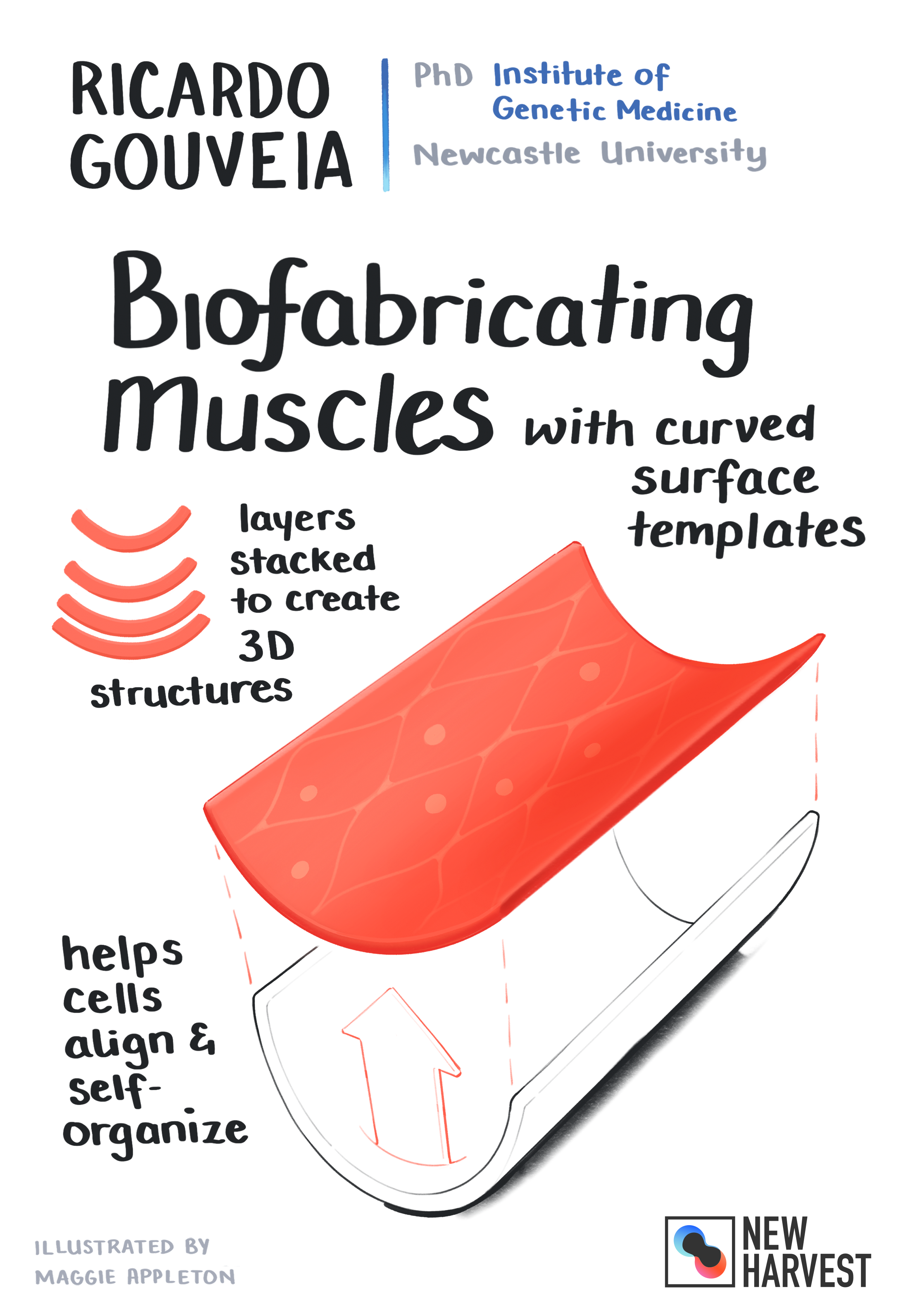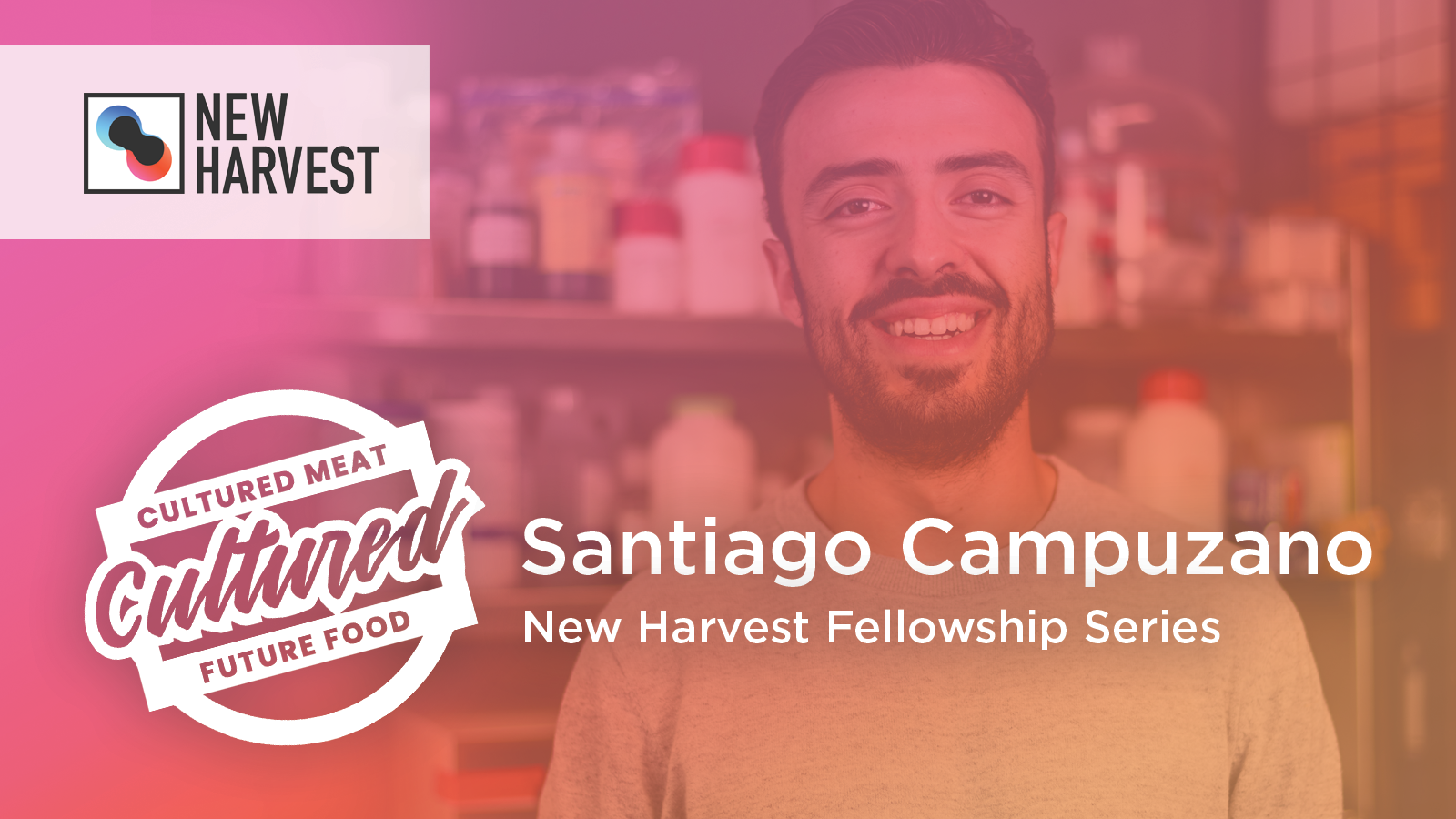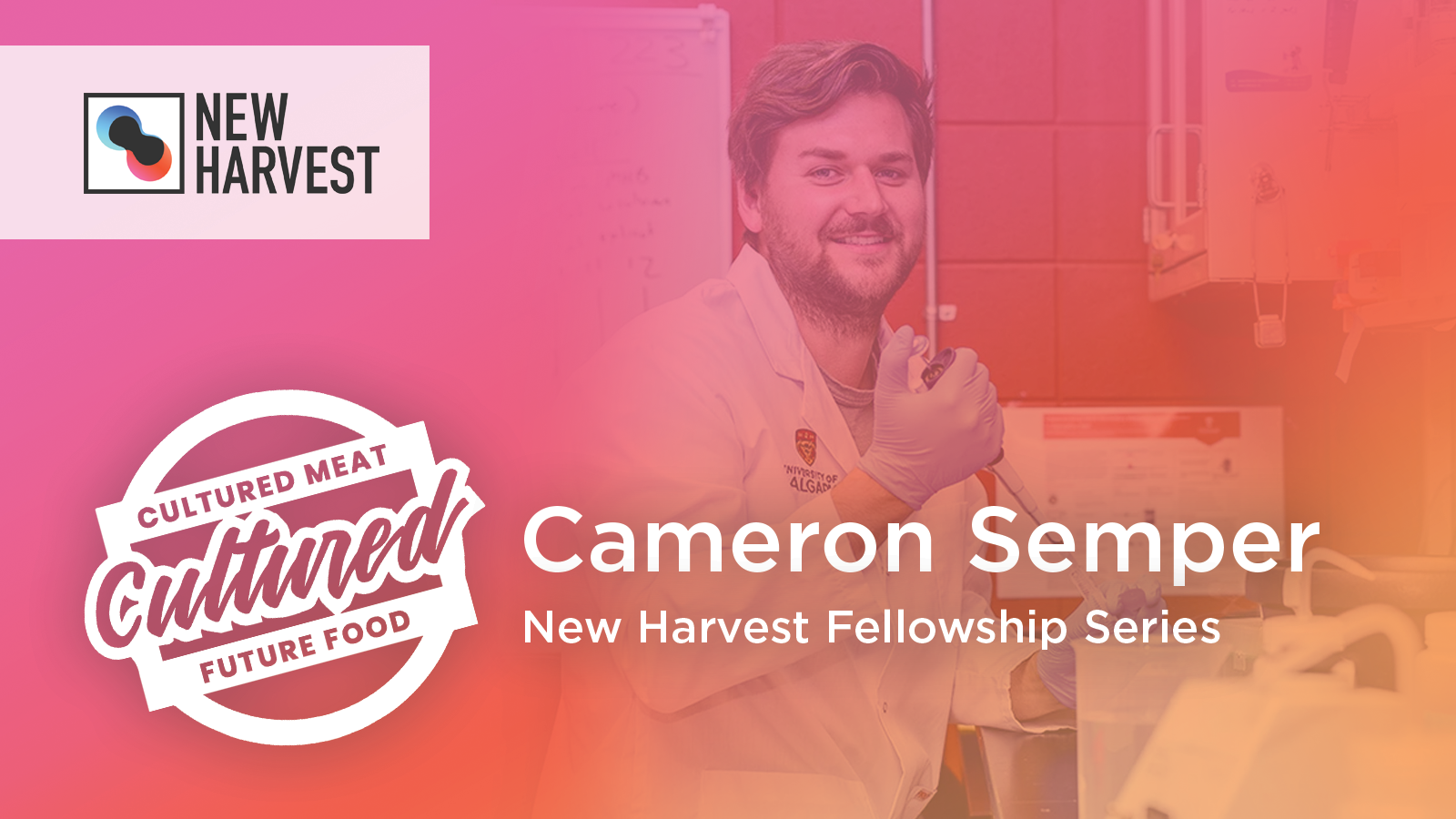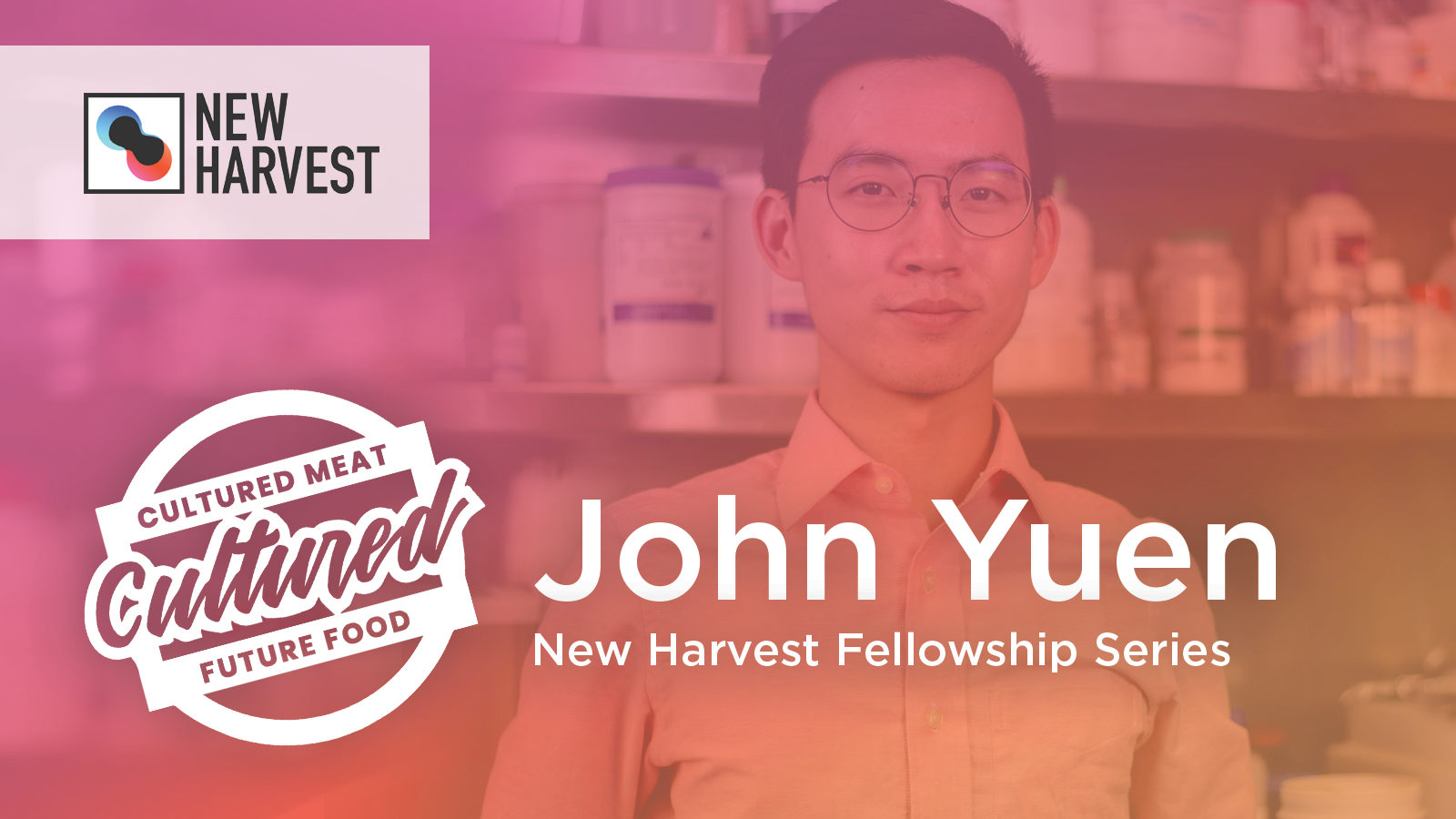Transcript
Also available on Spotify, Apple Podcasts, or wherever else you listen to podcasts!

Alex (00:04):
Thanks for joining us on the Cultured Meat and Future Food show. On this episode, we’re excited to have Ricardo Gouveia as part of the New Harvest Fellowship series. Ricardo completed his Licenciatura degree in biology from the University of Lisbon in Portugal, back in 2004, where he developed an eclectic taste for knowledge. He pursued this craving at the world-renowned Institute of Technological Chemistry and Biology from the Nova University in Lisbon, where in 2010, he was awarded with his Doctorate in biochemistry for his work on cell adhesion molecules and how they can be used to control stem cell behavior or inhibit cancer progression. In 2012, his eagerness to expand on his personal and scientific menu of skills led him to the UK, where he joined professor Che Connor’s Tissue Engineering lab as a research associate. Since then, his research interests have forked into multiple fields, and allowed me to make new and exciting discoveries relevant to areas as diverse as healthcare, bio-manufacture and food.
Alex (01:08):
In December 2018, Ricardo was awarded the first ever postdoctoral research fellowship from New Harvest, a US-based organization supporting cultured meat science internationally. This position gave him the freedom to perform independent research on structured meat biofabrication as well as to create his very own spin out company, 3D bio tissues, which aims at delivering next generation transplant tissues to millions of patients around the world. Let’s jump right in. Ricardo, I’m excited to welcome you to the Cultured Meat and Future Food show. Tell us a little bit about your background and when you actually first started your studies.
Ricardo (01:48):
Thanks for having me, Alex. Yeah, I started as a biologist. I graduated from the University of Lisbon in 2004 as a general biologist. And then after that, I immediately started my PhD studies in 2004 up to 2010, looking at new and better ways to use surfaces as a way to regulate how stem cells differentiated, how can we manipulate their behaviour and achieve a certain preconditioned cell fate. After that, I really felt that I needed some international experience. Both my graduate studies and PhD studies were all performed in Lisbon in Portugal. After that, I felt that in order to grow as a scientist and also as a person, I really needed to have international research experience. So in 2012, I moved to the UK to continue, in a way, work in the new ways to interfere with cell behavior, specifically regulate STEM cell behavior using smart surfaces. So since I’m in the UK, I’ve been developing my research very much targeted into the creation of new solutions to use stem cells therapeutically. And that has by using cells and controlling these cells to create new tissues that in every way are equivalent to tissues of the human body, including tissues of the human cornea, so the front of the eye, that despite appearing very simple, they are highly complex in structure and composition, but also of the human skin and other tissues of the human body, in particular for biomedical applications.
Alex (04:13):
Cool. Actually, this actually has sparked some more questions on my end. So before we even get into cultured meat, so when we hear induced pluripotent stem cell, is that the same thing that you’re working on to then turn that into the cornea?
Ricardo (04:28):
In a way. So what scientists have discovered in the last 40 years is that there are several types of stem cells. There are the embryonic stem cells, the ones that are able to differentiate into every single cell type in our body, but then there are other stem cells from the adult tissues that have a lower differentiation potential. And that’s makes the difference between the pluripotent cells, like the ones we find in embryonic tissues, as well as the ones that are manipulated by scientists in order to have greater differentiation potential, and all other cells that have lower potentials, and these are called multi potent. These cells are also called progenitors because they have a certain lineage, but they are already slightly conditioned to differentiate into multiple cell types, but all of that same lineage. So there is no rigid confinement of cell types. What we have discovered is that there is a wide range, a wide spectrum of stem cell types.
Alex (05:54):
Okay, cool. Tell us about your research related to cultured meat.
Ricardo (05:59):
So it was really exciting to develop all these solutions for biomedical research, but then I think it was early 2017, 2018 that I started realizing that all the techniques and all the methods that I’ve been developing for the last maybe 10 years actually could be applied to other areas as well. And it was in 2018 that I discovered New Harvest. So New Harvest is really interested in potentiating this translation of knowledge from a tissue engineering / biomedical research background. All this knowledge that has been growing for the last 40 or 30 years into a particular application in terms of food production and alternative food and protein sources. And that is incredibly exciting because I then realized, the same time I discovered New Harvest, that in fact, all these techniques and strategies I’m still using in my research could very easily be applied into muscle or fat tissue engineering that can then address very specific challenges in cultured meat. In particular, the work that I’ve performed in corneal research, where structure and high degree of tissue organization is fundamental for the function of the tissue, is very much a challenge also in cultured meat, where the alignment of cells and the alignment of tissue is paramount for the texture of the tissue. And eventually also it’s perceived taste.
Ricardo (07:56):
So in a remarkable parallel development, we were without knowing actually building up a methodological and fundamental base of knowledge that can very much be easily translated into a completely different field of study. Now, of course, the challenges between the two fields are quite distinct. I’m going to think about creating new transplantable tissue for human medical use, price is typically not in the forefront of your criteria. The safety, the nutritional value, all those things are not something that is not very much considered when we are thinking about biomedical research. In contrast, when you are creating alternatives for meat, then you need to consider these will have to be produced for mass consumption. That very much reduces the strategies that you have available in order to develop such alternatives. Moreover, when we were looking at developing tissues for biomedical applications, there are a number of considerations in terms of growth factors in terms of materials that you can use that are not suitable at all for cultured meat.
Alex (09:26):
Mmhmm. And it’s funny because price becomes everything once you look at it in a different light. Are you currently doing any research on corneal tissue or the cornea, or have you transitioned fully to research related to cultured meat?
Ricardo (09:40):
No, indeed. I’m still doing very much active research in corneal tissue engineering as well as in other tissue engineering projects. Indeed my time is currently divided into three main projects. I’m still very much working as a Research Associate at the University of Newcastle,looking into the development of new strategies to create solutions for corneal and therapies while doing also my work in cultured meat, very much funded by ostdoctoral research fellowship from New Harvest, in which I’m translating all the work from corneal tissue engineering into muscle cell tissue engineering and developing new strategies to create aligned muscle tissues that can recapitulate what we observed in the animal. And my third hat, if you will, is as an entrepreneur. So we realized at a certain point that many of the technologies and the methods that we have developed in the last 10 years or so were quite exciting, but there was no way they could move forward from the stage of discovery into the stage of clinical application, because then you have to have a commercial exploitation and development of these ideas. So what we performed was a startup company who started this in late 2019 in order to bring into the market, accelerate into the market, all these ideas developed in academia. So basically I’m wearing three hats with feet in both academia and industry, which is quite exciting place to be.
Alex (11:47):
Great. And that third tier or the entrepreneurial endeavor, that’s 3D Bio-Tissues, is that correct?
Ricardo (11:54):
Yes. So Che and I, Che is my supervisor and a mentor, we founded 3D Bio-Tissues in late 2019. We are using this startup as an accelerator, if you will, of these products, mainly at this point, aiming at developing medical solutions, but eventually aiming the funding into cultured meat as well.
Alex (12:25):
Great. And I believe you are also working on research related to the Good Food Institute through a Good Food Institute grant. Can you tell us a little bit about that?
Ricardo (12:36):
Yes, absolutely. It is quite exciting to see there are now multiple avenues of funding for the mental and applied research on cultured meat. And this is definitely a growing field. So the idea behind our Good Food Institute project is mainly looking at higher efficiency in cell growth and biomass production. One thing that we realize is that depending on the type of growth medium that you use, you have cells growing more or less quickly, but fundamentally the growth media that people are using is very much based on the same principle. They haven’t changed since tissue engineering started almost 100 years ago. They did not really reflect the biochemistry of in vivo conditions. In particular, the crowding environment of tissue engineering culture conditions, it’s much sparser. So that really affects how cells grow, how proteins interact with each other, proteins that are either used by cells as nutrition or growth factors, as well as how nutrients are available for themselves. So our project is a very much proof of concept stage, but we really want to understand if there are easy methods to increase how cells perceive their environments in terms of molecular crowding and increase the rates, the kinetics, of which cells work.
Alex (14:40):
Great. And so there’s two terms, differentiation and proliferation. Can you give us a very high level definition of each of these terms as relates to not just tissue culture, but cell cultured meat? So for example, when we mentioned differentiation, can you tell us what that is in the context of cultured meat?
Ricardo (15:01):
Differentiation is the ability of certain cells, either stem cells or progenitor cells to become muscle cells. So cells from an adult muscle, these cells do not divide very much, but they are essential. They are essential for the constructability of muscle and for the function of the muscle. And these comprise the majority of the biomass that forms the muscle. So in order to have a cultured meat product that actually looks like, and tastes like natural meat, you have to have fully differentiated muscle cells forming that tissue. In terms of proliferation, that is very much what is in our minds all the time. So one of the advantages of working with stem cells is that these cells have the ability to divide and expand, proliferate increase in their numbers. And that is essential because you usually start with a very low number of cells from a sample. And in order to upscale the amount of biomass you need this house to proliferate. So typically the process of creating cultured meat involves a first stage on which the cells proliferate in large quantities while still remaining their stimulus or their proliferative capacity. And then the second stage on which they are differentiated and assume a shape and function of mature adult muscle tissue. And the same can be for other cell types comprising in the meat, such as fat cells and fibroblasts, etc.
Alex (17:09):
So scientifically, you know, how many times can these cells divide and what happens when they cannot divide anymore? And is this a challenge that we’re facing?
Ricardo (17:18):
Now? One of the main challenges in cultured meat is actually to maintain proliferation in cells in particular, because we don’t know all the cues these cells are exposed to. We have a constant, although slow, loss of proliferative ability in the stem cells that we use in our processes currently. So what you have is an initial pool of cells that is highly proliferative, but because of the conditions that are not controlled 100%, this proliferative ability tends to disappear over time. And that is important because you would like to have a population of cells that once is isolated, can generate an infinite number of daughter cells. So yes, proliferation is very much one of the main challenges in all cell related technologies, cultured meat, for sure, but also in cellular therapies, for example.
Alex (18:27):
Okay, great. And so after your research projects conclude, what are your plans, do you plan to continue with entrepreneurial endeavors? You had mentioned interest in becoming a lecturer or perhaps more research, what are your thoughts?
Ricardo (18:43):
So I’m very much interested in seeing cultured meat as a field grow in academia. This I believe is incredibly important because it detaches the field from the immediacy of the concerns of industrial and commercial interests. In part, I think this is fundamental because there are many questions still unsolved that might not be tremendously important for a company aiming at producing cultured meat in mass, but might be still very important as biological question. The other thing is that this is an extraordinarily interesting field that I’m sure will attract many people to it, but the discoveries being made and will be made in this field will have an impact in neighboring fields, mainly for biomedical research. So this is kind of a two way trade. Cultured meats is only possible as a field of research because of all the legacy brought in from biomedical research.
Ricardo (20:02):
But the promise is that there will be a return. There will be many discoveries in the clean meat field that will be equally applicable to develop new biomedical solutions. And I think that’s one of the points that really drives me to try to actually become a lecturer in cellular agriculture or cultured meat. I think that there’s a lot to be explored and there’s multiple interconnecting areas of research that can be grown out of this, but I’m also very much enjoying my first steps as an entrepreneur. So it is possible I think, to maintain one foot in each of these areas. So I’m very much keen to do something.
Alex (20:45):
Great. So the next question is a fun question that I’ve been asking on some of the shows lately, and it’s ‘if someone was to walk into your workspace in the lab, what would they see?’ And you could mention either equipment or people or books or anything. So if somebody was to walk into your lab space, what would they see?
Ricardo (21:07):
So one of the things, one of the pieces of kits that actually people notice immediately is a 3D bio-printer that we have in our lab that we have been using to develop certain research in cornea and corneal tissue engineering that we very much like to use in other applications as well. I think the lab, we recently moved to a new cell culture lab. And the first thing that people will also notice is how small it is. It’s very tidy, very cozy, but very small. It’s the size of a medium sized cupboard. So I think one of the interesting things that I liked that people notice is tidiness. And that is really important when you are developing high level research, you really need to try to control as many variables as possible. There are already so many that are completely uncontrollable, that if you can reduce the ones that you can control them, even better. So ultimately it is a small lab. That’s very, very tidy, very, very clean to reduce all the risks of contamination and variables affecting the cell growth. This can be temperature. This can be pressure. This can be access to external environment etc.
Alex (22:28):
Yeah. And it’s funny to think about, you know, we think about cleanliness and tidying quite a bit now because of coronavirus. And I feel like some of these science lab environments are definitely some of the most sterile and cleanest environments you can be in whether it is the time of coronavirus or not.
Ricardo (22:46):
Absolutely. And quite frankly, I think coming from a biological background and tissue engineering field of research, you can really understand that in order for the cells to grow, you need to maintain a sterile environment and that can be accomplished without even the use of antibiotics. Again, this is one of the main selling points in a way for cultured meats, the ability to produce food in very controlled conditions in highly clean environments without the need of introducing antibiotics into the food chain.
Alex (23:25):
Great. You can learn about Ricardo on LinkedIn. Learn about New Harvest at www.new-harvest.org and 3D Bio-Tissues at 3dbiotissues.com. Ricardo, do you have any last insights for our listeners and our audience today?
Ricardo (23:44):
Yeah, I think you mentioned the coronavirus – now it’s impossible to avoid talking about this. I think it’s quite important to be aware of these kinds of viruses and infectious diseases. Some of them have been associated, and I think this one has been associated with animal consumption, so they are called zoonotic diseases because they are associated with animals close proximity with humans or animals. So again, I think this is a true reflex of the impact of human activity on the environment and then on the receiving end ends up being also affecting human health. I think there are many things that we can learn from cultured meat and some of those things related to foods and nutrition and good nutrition, but others are also very much related to biomedical research. So I look forward to be involved in this crosstalk for many years to come.
Alex (24:48):
Absolutely. Ricardo, thank you so much for being with us today on the Cultured Meat and Future Food show.
Ricardo (24:55):
It was my pleasure Alex.
Alex (24:56):
This is your host Alex and we look forward to being with you on our next episode.
Transcribed by New Harvest volunteer Bianca Le.
To stay up to date on New Harvest research updates and events, sign up for our newsletter.




